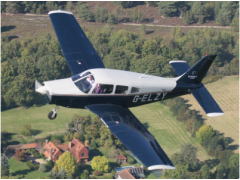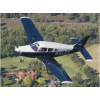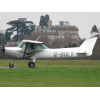Introduction. The European Aviation Safety Agency Private Pilot’s Licence (EASA PPL) is the most popular and flexible private licence. It allows the holder to fly a greater range of aircraft, to use their licence worldwide and to add additional ratings and qualifications to allow flight at night or in more limiting weather conditions. Your Private Pilot’s Licence consists of 4 parts:
Ø Private Pilot’s Licence (says I can fly) Ø Rating & Qualifications (says what I can fly)
Ø Radio Licence (says I can use the radio) Ø Medical (says I am fit to fly) Minimum and Maximum Age. There is no minimum or maximum age to start flying; however flight time can only be credited towards your license after the age of 14, a candidate can fly solo at 16 and apply for their license at 17.
Flight Training Requirements. Candidates complete a minimum of 45 hours of flight training before undertaking the Private Pilot’s Skill Test. Flight training starts by developing the fundamentals of aircraft handling before progressing through to your first solo flight and cross country navigation. The flight training must include the following:
Ø 25 hours of dual instruction with a qualified instructor including:
Ø 2 hours of stall spin awareness and avoidance training.
Ø 10 hours of supervised solo flight including:
Ø 5 hours of cross country flying including one qualifying cross country flight of at least 150nm with landings at two other aerodromes.
Ø 5 hours of training may be conducted in a Flight Simulator or Flight and Navigational Procedures Trainer (FNPT), although most candidates complete all the required flight training hours within the aircraft.
Synergy Aviation Fairoaks Flight Centre Fairoaks Airport Chobham Woking Surrey GU24 8HX UK
Telephone: +44 (0)1276 858 075 Email: info@flysynergy.com
Theoretical Knowledge Subjects. Seven subject areas and their associated exam provide the technical foundation to your flight training. The exams range from ½ to 1½ hours in duration and have multiple choice answers. All exams must be completed within an 18 month period starting from the end of the calendar month when the applicant first attempted the examination. Exams remain valid for 24 months after the completion of the last exam. Aviation Law and Operational Procedures must be completed before first solo and all exams must be completed before undertaking the Private Pilot’s Skill Test. The subject areas are:
Ø Aviation Law and Operational Procedures Ø Aircraft General and Principles Of Flight
Ø Communications Ø Flight Performance and Planning
Ø Human Performance & Limitations Ø Meteorology
Ø Navigation & Radio Aids
Radiotelephony Operator’s License (FRTOL). The Flight Radiotelephony Operator’s License
forms part of a separate practical test. Although recommended, completion of the practical test is not
required before undertaking the PPL Skills Test.
Medical Requirements. A valid European Aviation Safety Agency (Part-MED) Class 1 (Professional)
or Class 2 (Private) medical certificate is required prior to completing a student’s first solo and to use your licence.
Training Credits. Credits towards flight training and theoretical elements are available. These are dependent upon previous flight training and experience. Private Pilots Licence Skills Test. The PPL Skills Test is undertaken once all flight training and theoretical examinations are complete. The PPL Skills Test breaks down into the following sections:
Ø Pre-flight planning including:
Ø Weather and airspace interpretation plus aircraft performance planning.
Ø Flight test to demonstrate the following abilities:
Ø Fly both a pre planned navigation route and on route diversion.
Ø General aircraft handling including a selection of simulated emergency drills.
Ø Complete a range of approaches including normal, flapless and glide to land.
Synergy Aviation Fairoaks Flight Centre Fairoaks Airport Chobham Woking Surrey GU24 8HX UK
Telephone: +44 (0)1276 858 075 Email: info@flysynergy.com
Currency. To exercise the privileges of your PPL all elements of your licence including relevant ratings must be current. To carry passengers the pilot in command must have completed at least 3 take offs and landings as the sole manipulator of controls of an aircraft of the same class during the previous 90 days. In addition to licensing requirements, most clubs require a minimum 28 day currency on their aircraft to provide additional safety and comply with insurance requirements. Please find a brief summary of key items listed below and see the associated sections within the Civil Aviation Publication 804 (CAP 804) for full details.
Ø Private Pilot’s Licence
Ø Valid for life as long as the holder has a current medical and rating associated with the licence.
Ø Class Rating
Ø The Single Engine Piston Rating (SEP) associated with most PPL is valid for 2 years. It may be revalidation by either:
Ø Completing 12 hours of flying within the second year of validity. This must include 6 hours as Pilot in Command, 12 take offs and landings and a 1 hour flight with an instructor.
Ø Passing a proficiency check with a Flight Examiner.
Ø Radiotelephony operator’s license (FRTOL). Valid for life on the condition that the holder is proficient to
English Level 6 (Expert).
Ø Medical. Valid between 5 years and 6 months subject to class of medical and age of holder. Can be renewed by an Aeromedical Examiner (AME).
Additional References. Additional information can be found by using the following links:
Ø EASA PPL: CAP 804 – Section 4 – Part C
Ø Aircraft Ratings: CAP 804 – Section 4 – Part H
Ø Radiotelephony: CAP 804 – Section 6 – Part A













